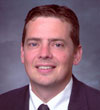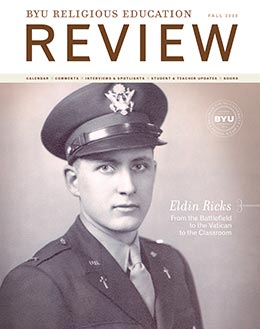Thomas A. Wayment thom_wayment@byu.edu was an associate professor of ancient scripture at BYU when this was written.

Located nearly one hundred miles south of Cairo and west of the Nile, the ancient city of Oxyrhynchus (modern el-Bahnasa, Egypt) was a thriving city in Roman times and at one time boasted a large Christian community beginning in the late second century and reaching its pinnacle in the fourth and fifth centuries. After the Muslim conquest of Egypt (AD 641), the Christian community began to decline significantly towards the end of the seventh century. Because of its relative obscurity and the preference by archaeologists to excavate more glamorous sites, Oxyrhynchus was neglected until 1897, when two Oxford fellows, Bernard Grenfell and Arthur Hunt, began digging at the site with the hope of discovering discarded papyri hidden in the ruins of the ancient city.
Outside the ancient city of Oxyrhynchus, several rubbish mounds lay undisturbed and appeared to be relatively uninteresting. Grenfell, in particular, felt that these rubbish mounds had very little to offer the excavators, and he wrote in his own diary that they contained nothing more than ancient rubbish. The team soon realized, however, what lay underneath the mounds, and eventually they unearthed the largest collection of papyri ever discovered, eventually yielding roughly 500,000 papyri fragments, the vast majority of which represent singular texts. Most of the papyri were written in Greek, although there are a few Latin and Coptic texts dating to the Ptolemaic, Roman, and Byzantine periods. Even though 90 percent of the papyri are documentary—recording tax burdens, contracts for the sale of goods, and other mundane affairs of daily life—nearly 10 percent are literary and preserve classical and biblical texts.
No one had expected the discovery of so many papyri, and the excavators commissioned local crews to make tin boxes so the papyri could be safely transported back to Oxford. Some of the papyri were even transported in old kerosene cans that were cut apart and made into boxes. The crews making the boxes struggled to keep up with the excavators, who were excavating hundreds of papyri each day.
After the papyri were cleaned, flattened, and placed under glass, they were edited and prepared for publication. Although the papyri have been consistently edited and published since their initial discovery, only a small percentage of the entire collection has appeared in print, perhaps one percent of the total number of papyri discovered. Over the past century the curators of the collection have faced several different obstacles in editing the papyri for publication, namely abraded and damaged surfaces, obscured text, papyri that were reused (thus containing two texts per page), and a variety of surface corruptions.
In 2006 a team of scholars from Brigham Young University, including Thomas A. Wayment from the Department of Ancient Scripture, traveled to Oxford to apply multispectral imaging to the problematic papyri. Previously, this technology had yielded impressive results on burned texts and other texts that were difficult to read because of similar surface damage. During the trip to Oxford they were permitted to image a wide variety of texts to determine whether the technology could unlock the text of the difficult-to-read papyri.
Because Oxyrhynchus has so far yielded roughly half of the oldest New Testament papyri, as well as texts of classical authors such as Homer’s Iliad and Odyssey, the plays of Euripides, Sophocles’s Oedipus Rex, Euclid’s Elements, and other important Greek and Latin authors, the potential to randomly select papyri and produce new editions of them was enormous. As for Christian texts, Oxyrhynchus has provided scholars with fragments of all four Gospels, Romans, the majority of Paul’s epistles, and apocryphal texts such as the Gospel of Thomas, the Gospel according to the Hebrews, and the Shepherd of Hermas. A text the team selected was P.Oxy 2383, one of the oldest fragments of the Gospel of Luke. Importantly, this fragment contains on its front side the text of Luke 22:41– 45, but it skips over the verse that records the appearance of an angel from heaven to strengthen Jesus while He prayed in Gethsemane and the verse mentioning Jesus’s sweat as great drops of blood. This fragment and several later texts have led some scholars to conclude these verses were a later interpolation and were not part of what Luke recorded about Gethsemane.

Interestingly, King Mosiah refers to a similar event in the Book of Mormon when he prophesied, “for behold, blood cometh from every pore, so great shall be his anguish for the wickedness and the abominations of his people” (Mosiah 3:7). Although these verses in the Book of Mormon cannot confirm the similar verses in the biblical account, they do testify that Jesus did indeed sweat drops of blood as part of His anguish for His people.
As a result of the images taken in 2006, the team was able to reedit P.Oxy 2383 and conclude definitively that the text has suffered corruption and scribal correction. Specifically, the new edition of this fragment raises the distinct possibility that Luke 22:43–44 may have been excluded from this particular fragment because of scribal error and not because those verses were not originally part of the biblical text.
The BYU team is currently working on a fragment of the Gospel of Peter (P.Oxy 2949), as well as several texts that have not yet appeared in print. One is of particular interest for biblical scholars and contains an unpublished fragment of the text of Philemon. This fragment will likely confirm the already established text of Philemon as we have it in our New Testament today, but frequently the papyri will offer variant readings and changes in wording. The team is also working on several early fragments of the Gospel of Matthew that show signs of scribal correction. Multispectral imaging technology may also provide a tool for differentiating between inks on a single papyrus leaf, and they are working with the Matthew fragments to determine if indeed it will be possible to detect the hands of the original author and a later corrector.
